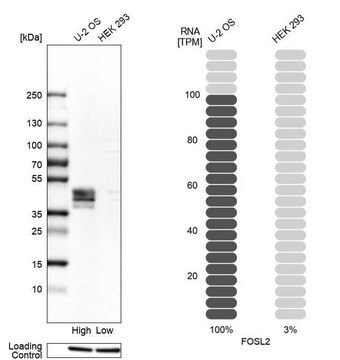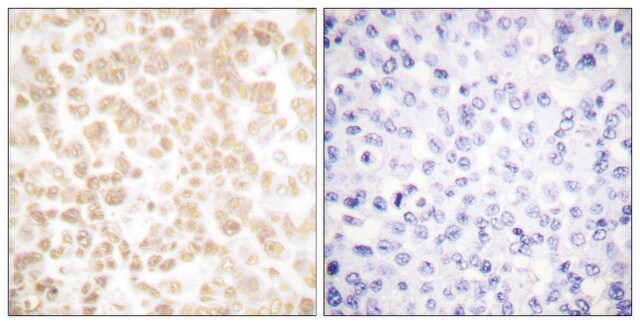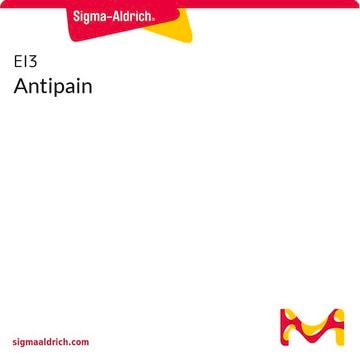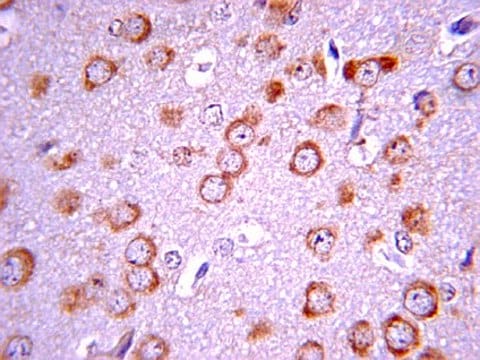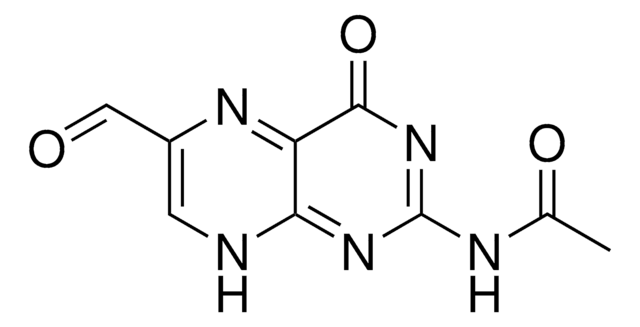MABS1261
Anti-FRA-2 Antibody, clone REY146C
clone REY146C, from rat
Synonym(s):
Fos-related antigen 2, FRA-2
About This Item
Recommended Products
biological source
rat
Quality Level
antibody form
purified immunoglobulin
antibody product type
primary antibodies
clone
REY146C, monoclonal
species reactivity
mouse
technique(s)
ChIP: suitable
immunofluorescence: suitable
immunohistochemistry: suitable (paraffin)
immunoprecipitation (IP): suitable
western blot: suitable
isotype
IgG2aκ
NCBI accession no.
UniProt accession no.
shipped in
wet ice
target post-translational modification
unmodified
Gene Information
mouse ... Fosl2(14284)
General description
Specificity
Immunogen
Application
Western Blotting Analysis: A representative lot detected a FRA-2 upregulation in cultured mouse keratinocytes (mKCs) upon Ca2+-induced differentiation. ERK1/2 inhibitor FR180204 (Cat. No. 328007) reduced Fra-2 level in mKCs upon Ca2+ treatment (Wurm, S., et al. (2014). Genes Dev. 15;29(2):144-156).
Immunoprecipitation Analysis: A representative lot co-immunoprecipitated Ezh2 with Fra-2 from lysates of cultured mouse keratinocytes (mKCs) prior to, but not after, Ca2+-induced differentiation (Wurm, S., et al. (2014). Genes Dev. 15;29(2):144-156).
Chromatin Immunoprecipitation Analysis: A representative lot detected FRA-2 association with EDC promoters at conserved AP-1 consensus sites in cultured mouse keratinocytes (mKCs) under both basal and differentiation conditions (Wurm, S., et al. (2014). Genes Dev. 15;29(2):144-156).
Immunohistochemistry Analysis: Prior to antibody purification, the culture supernatant detected FRA-2 immunoreactivity in paraffin-embedded skin sections from wild-type, but not Fosl2-knockout mice (Courtesy of Dr. Erwin Wagner, Spanish National Cancer Research Centre (CNIO), Madrid, Spain).
Immunocytochemistry Analysis: Prior to antibody purification, the culture supernatant detected exogenously expressed murine FRA-2 (mFRA-2), but not mFRA-1 or mFosB in transfected HEK293T cells (Courtesy of Dr. Erwin Wagner, Spanish National Cancer Research Centre (CNIO), Madrid, Spain).
Signaling
Transcription Factors
Quality
Western Blotting Analysis: 0.5 µg/mL of this antibody detected FRA-2 in 10 µg of MEF1 cell lysate.
Target description
Physical form
Storage and Stability
Other Notes
Disclaimer
Not finding the right product?
Try our Product Selector Tool.
Storage Class Code
12 - Non Combustible Liquids
WGK
WGK 1
Flash Point(F)
Not applicable
Flash Point(C)
Not applicable
Certificates of Analysis (COA)
Search for Certificates of Analysis (COA) by entering the products Lot/Batch Number. Lot and Batch Numbers can be found on a product’s label following the words ‘Lot’ or ‘Batch’.
Already Own This Product?
Find documentation for the products that you have recently purchased in the Document Library.
Our team of scientists has experience in all areas of research including Life Science, Material Science, Chemical Synthesis, Chromatography, Analytical and many others.
Contact Technical Service